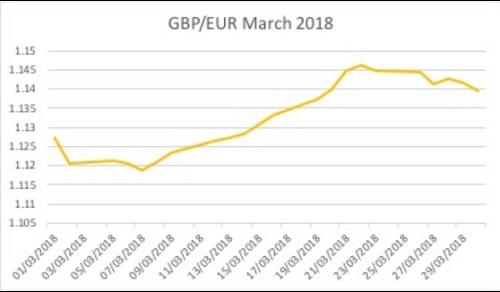Sterling/Euro Exchange Rate Review March 2018
Friday 06 April 2018
The pound to euro exchange rate began March at interbank levels of €1.12, but rose above €1.14, briefly reaching a two-month high at €1.15, writes Ben Scott of FC Exchange.
At the start of the month (7th March) the pound hit its lowest level against the euro since November 2017 as Brexit developments dragged the British currency down. Leaked documents showing the UK could end up with a free-trade agreement similar to Canada pressured sterling lower.
The downward shift was further exaggerated by UK gross domestic product (GDP) estimates at 0.3% in February, down from 0.4%, a widening in the visible trade deficit in January, and bad news for the UK construction sector which noted a -3.4% fall in January’s output after the collapse of industry giant Carillion.
However, the pound picked up on the 13th March when Chancellor of the Exchequer Phillip Hammond delivered his Spring Statement. Additionally, optimism about March’s Brexit meetings bolstered sterling significantly.
On the 19th of March sterling enjoyed another surge higher when it appeared the UK government was close to securing a Brexit transition deal.

Bank of England (BoE) Bolsters Sterling
The Bank of England’s (BoE) 22nd March interest rate decision saw policymakers vote in favour of keeping interest rates on hold. However, two of the nine members of the Monetary Policy Committee (MPC) voted to move interest rates immediately, making hawkish remarks that it would be reckless to wait.
On account of the development, the pound to euro (GBP/EUR) exchange rate broke above the 1.15 level marking a two-month high and reached a seven-week high against the US dollar (GBP/USD) at 1.42.
European Central Bank (ECB) Drags Euro Lower
The European Central Bank (ECB) pulled the single currency lower on a few occasions in March. ECB President Mario Draghi commented that the central bank would be willing to drop the stimulus programme should the currency bloc perform well, but also stated that Eurozone inflation could remain subdued moving forwards. Draghi hinted that monetary policy would need to stay reactive, leading markets to believe that stimulus could go on for longer if needed.
The pessimistic ECB comments continued on the 16th March and dampened the euro further, when Chief Economist Peter Praet stated that the Eurozone economy had some unexpected slack which could cause inflation to remain sluggish.
Italy’s Election Still Unclear
The Italian election on 4th March yielded no clear winner which caused the euro to soften slightly. Now moving into April, the Italian President, Sergio Mattarella, is looking to begin coalition talks a month on from the inconclusive election. The populist Five Star Movement managed to attain the largest amount of votes, but didn’t gain enough to form a government alone. The other victor was the right-wing League party, which would also need support from other parties to form a government.
The currency market has been relatively accepting of the political deadlock in Italy, but if the Five Star Movement were to come into power, there could be some rocky days ahead for the euro as there have been previous murmurings from the party of an EU referendum.
GBP/EUR Exchange Rate Forecast
The pound to euro (GBP/EUR) exchange rate is likely to be sensitive to Brexit negotiations in the next few months as the June summit approaches. Businesses will want to see what kind of trade deal the UK will receive, and the pound could fluctuate as a result. Now that the prospect of a cliff edge Brexit has been avoided with the transition deal, interim Brexit fluctuations could be less dramatic than before, but large movements could still take place on trade deal prospects.
Brexit isn’t the only political event that could create GBP/EUR exchange rate movement; investors will be keeping an eye on how the Italian coalition talks play out to see if one of the Eurozone’s largest economies could be on a path that might involve a referendum further down the line.
In March it was revealed that inflation had fallen from 3.0% to 2.7% on the year in February, the weakest level since July 2017.
Additionally, the three months through January showed UK wages had risen at their quickest pace in around two-and-a-half years.
Investors will be carefully watching the next set of wage growth figures to see if real earnings overtook consumer prices in February. March also showed the UK’s rate of unemployment sank to 4.3% - the joint-lowest level since 1971. Any improvements on this could help sterling further, but a shift higher could be less positive for the British currency.
Growth figures are another factor to watch in the near future as the UK’s the only major economy in the world where growth is slowing rather than quickening.
Economist John Hawksworth commented: "Among the G7, the UK was the only economy to see a deceleration in growth between 2016 and 2017, which does point to the dampening impact of Brexit-related uncertainty on UK business investment and the squeeze on consumers from the weaker pound pushing up UK import prices in 2017."
Since the Brexit referendum there has been speculation that the UK will enter a recession; any slips in growth could bode badly for the pound as the UK looks to leave the EU.
Ben Scott
Foreign Exchange Ltd
www.fcexchange.co.uk
Thank you for showing an interest in our News section.
Our News section is no longer being published although our catalogue of articles remains in place.
If you found our News useful, please have a look at France Insider, our subscription based News service with in-depth analysis, or our authoritative Guides to France.
If you require advice and assistance with the purchase of French property and moving to France, then take a look at the France Insider Property Clinic.





